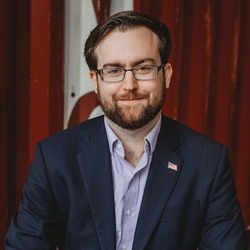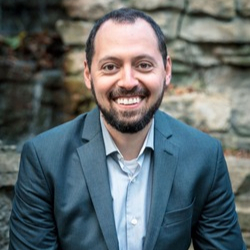
Matt Cordio is the President and Chair of MedServe, a healthcare technology company providing digital narcotic management solutions for ambulatory surgery centers and outpatient clinics. He acquired the company through Tomorrow River Ventures, which he founded and continues to serve as the managing partner. As a serial entrepreneur, Matt co-founded the Wisconsin Startup Coalition, an advocacy voice of Wisconsin’s startup founders, and founded Skills Pipeline, where he serves as a partner and advisor.

Alex Yampolsky, PharmD, MBA, is the CEO of MedServe. Before joining MedServe in 2022, he co-founded Vytal Health, a telemedicine startup focused on integrative medicine, and held leadership roles at TelePharm and Aurora Health Care.
Here’s a glimpse of what you’ll learn:
- [00:42] Matt Cordio and Alex Yampolsky introduce themselves and share their passion for drug diversion
- [02:51] What is drug diversion, and how does it impact ASCs and hospitals?
- [07:15] Common methods of drug diversion and the vulnerabilities in various healthcare settings
- [13:40] Real-world examples of drug diversion cases and their devastating effects on patients and facilities
- [17:39] The prevalence of drug diversion in healthcare settings and why it’s underreported
- [24:26] How MedServe’s digital narcotic management system enhances medication security
- [31:44] Low-cost strategies healthcare facilities can implement to minimize drug diversion risk
- [36:41] Red flags healthcare leaders should observe to detect possible drug diversion
In this episode…
Drug diversion poses a serious threat to healthcare facilities, particularly ambulatory surgery centers, where vulnerabilities in medication management can have devastating consequences. The misuse or theft of narcotics endangers patient safety and exposes facilities to legal, financial, and reputational risks. How can healthcare leaders safeguard their organizations against this pervasive issue?
Clinical pharmacist Alex Yampolsky and business leader Matt Cordio have developed a system for mitigating drug diversion in outpatient settings. Alex emphasizes the importance of implementing robust policies, conducting regular audits, and recognizing behavioral red flags among staff, such as frequent disappearances or discrepancies in narcotic usage. Matt also suggests transitioning from paper logs to digital narcotic management systems to improve traceability and accountability. Taking proactive measures like mock diversion drills, strong company culture, and clear reporting processes fosters safer healthcare environments.
In this episode of HealthTalk Insights, Danilo D’Aprile interviews Matt Cordio and Alex Yampolsky of MedServe, about addressing drug diversion in healthcare. Together, they discuss the risks of outdated medication management, DEA audit challenges, and cost-effective prevention strategies.
Resources mentioned in this episode
- Danilo D’Aprile on LinkedIn
- Merritt Healthcare
- Matt Cordio on LinkedIn
- Alex Yampolsky on LinkedIn
- MedServe
Quotable Moments:
- “It’s an easy thing to stand behind because it just ruins so many people’s lives.”
- “The implications are just horrific from a patient experience perspective.”
- “It’s very hard to detect through paper logging, which can be tampered with, or digital logging.”
- “You’re potentially leaving your facility open to the existential threat of a drug diversion lawsuit.”
- “This drug diversion, unfortunately, is a thing that either has already happened or it hasn’t yet.”
Action Steps:
- Establish strong medication management policies and procedures: Clear, enforced policies help reduce opportunities for diversion and ensure compliance during audits.
- Conduct regular mock diversion drills: Simulating diversion scenarios prepares staff to respond effectively and reinforces protocols before real incidents occur.
- Implement dual-person verification for narcotic access: Requiring two staff members to verify and log narcotic transactions adds an essential layer of oversight.
- Train staff to recognize behavioral red flags: Educating the team on warning signs like excessive medication use or frequent absences promotes early intervention.
- Transition from paper logs to digital tracking systems: Digital systems offer real-time monitoring, tamper-proof records, and better audit trails than manual logs.
Sponsor for this episode…
This episode is brought to you by Merritt Healthcare.
Merritt Healthcare is the industry leader in the development, management, and advisory of ambulatory surgery centers across the United States. They are an owner-operated firm committed to direct principal involvement.
They help partners maximize value while maintaining physician and patient satisfaction. Whether it’s operating guidance or business development initiatives, they are committed to going above and beyond.
To learn more, visit merritthealthcare.com.
Episode Transcript
Intro: 00:00
Welcome to the Health Talk Insights podcast, focusing on what is best for the healthcare consumer and how to impact positive change in US healthcare.
Danilo D’Aprile: 00:19
Welcome and thank you for joining Merritt Healthcare’s podcast Health Talk Insights. I am today’s host, Danilo D’Aprile, and today’s episode will feature unmasking drug diversion, safeguarding ASCs in hospitals. Joining me today are Matt Cordio, president of MedServe, and Alex Yampolsky, the CEO of MedServe. Matt and Alex, can you briefly introduce yourselves and share how you became passionate about addressing drug diversion and healthcare?
Alex Yampolsky: 00:42
Yeah, maybe I’ll I’ll kick it off. So my name is Alex Yampolsky. I’m a clinical pharmacist, CEO of MedServe. You know, the passion for drug diversion prevention is an easy problem to get behind because it just ruins so many people’s lives and unfortunately hurts a lot of clinicians, as many clinicians become addicted to medications. And as a clinician myself, as somebody who’s dealt with drug diversion many, many times throughout my career, it is it’s it’s an easy thing to stand behind.
And at the end of the day, it’s exciting because we’re improving people’s lives and making medicine safer, both for patients, but also for the clinicians that work with those patients and that are exposed to the narcotic that they interact with every single day.
Matt Cordio: 01:29
Yeah, I would add, you know, I got involved in the business. I’m not from a healthcare background, but had the opportunity to acquire the business back in 2021 and, you know, learn really about this drug diversion issue and the fact that narcotics and controlled substances in in healthcare facilities, ASCs and really, you know, fire departments, hospitals, healthcare, a lot of that is still being stored and tracked. You know, manually. And as somebody that I think everyone in, unfortunately, in this day and age may know somebody, a friend, family member who’s been impacted by opioid addiction. And there’s a great social impact of what we’re doing.
So, you know, that really attracted me to the opportunity. And seeing that we could scale a business to really work on helping healthcare professionals safeguard their facilities against this, you know, very dangerous and prevalent issue in healthcare.
Danilo D’Aprile: 02:36
That’s great guys. So for our listeners, can you define drug diversion in the context of healthcare facilities and explain why it’s such a crucial and critical issue for ASCs, as well as hospitals and tertiary care settings?
Alex Yampolsky: 02:51
Yeah, let me let me take that one on. So drug diversion really is basically theft of narcotics or using narcotics for a purpose they weren’t meant for or person they weren’t meant for. So in a kind of community of retail pharmacy setting, you can think of it as somebody gets a pain prescription and ends up selling those medications to someone else or giving them to someone else. But however, for us in healthcare operations and healthcare providers, it really usually entails somebody stealing narcotics from our facilities. Now, why is it such a crucial issue?
So it’s so crucial, not because of the dollars and cents that walk out the door when somebody steals medications. That is an impact. But it’s not the biggest impact here. The biggest impact is the safety of patient care. What ends up happening a lot of times is narcotics get diverted, and the patient does not end up getting the pain medication that they need.
Sometimes they end up getting sterile saline. Sometimes they end up getting tap water. And that could lead to a lot of infections, a lot of pain going through the procedure could also lead to death. The implications are just horrific from a patient experience perspective. Again, with death being the ultimate kind of terminal outcome of this.
But also for everybody else involved, there is a lack of trust that stems from this in a facility after a drug diversion case happens. Somebody you trust and work with side by side, ended up stealing medications from under your nose, took advantage of you and your organization. That creates a lot of mistrust amongst people and really can hurt company culture. But then also after an incident happens, there’s really tremendous financial implications. Some lawsuits are really as high as hundreds of millions of dollars in some cases, depending on how much patient harm happened.
But usually any legal expenses are usually nowhere less than $200,000 or even more.
[Continue to Page 2]



